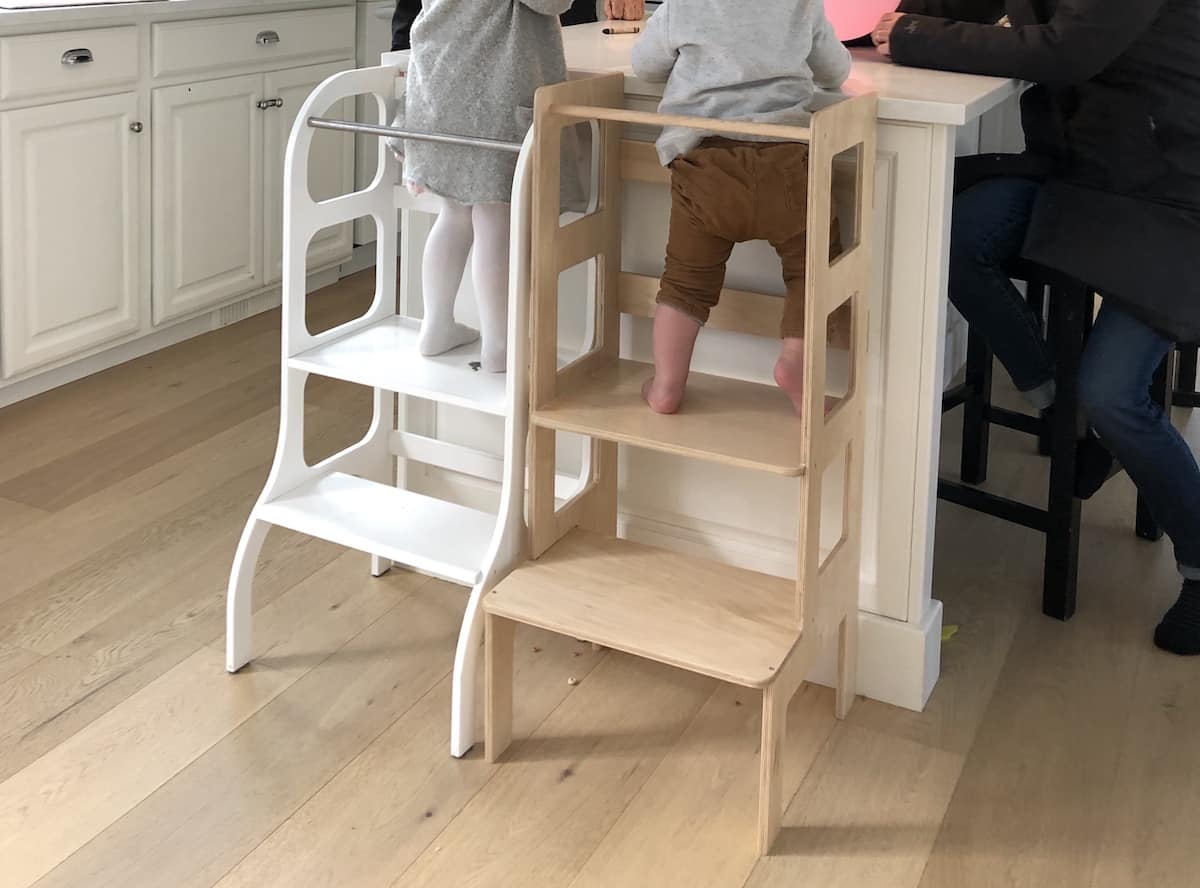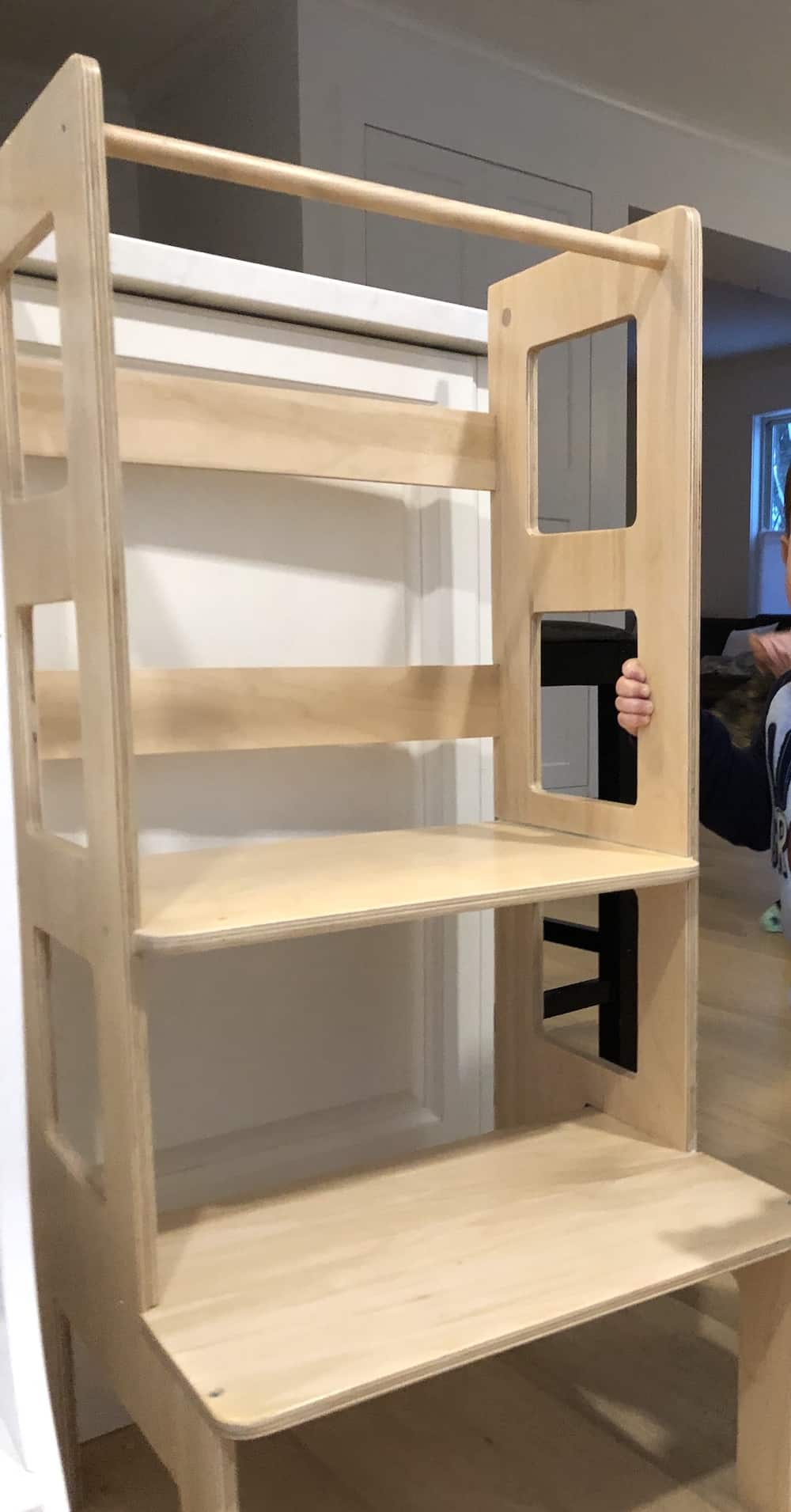If you’ve been following along with my most recent posts, you will have noticed that we’ve been talking a lot about Montessori in the home. While we’ve explored every room in detail, there is one furniture piece we haven’t given enough credit to… And they’re truly deserving of their own article!
Cue the Learning Tower! My favorite alternative to the boring old step-stool! I first mentioned these in my article “Montessori-Friendly Kitchen Tips For Parents & Educators“. Since kitchens are generally designed to be used by adults, young children may struggle to feel included and independent in the kitchen. Think about it from a toddler’s perspective – Rather than seeing all of the exciting things going on, like how their favorite meals are prepared, they’re seeing the underside of counters and constantly having to ask to be picked up to participate.
For this, kitchen towers offer a great solution! They bring your little ones up to be level with the counter… Which greatly increases their independence and lets them participate in whatever learning and creative process you’re up to in the kitchen. Now they can enjoy a whole new world of learning opportunities like learning to cook, bake, and do kitchen duties like washing fruits/veg and dishes!

Let’s go over some of the most popular questions when it comes to Learning Towers before getting into their pros and cons:
What is a learning tower?
Also sometimes called a kitchen helper, I like to think of learning towers as an upgraded kitchen stool… One that keeps your little one protected in a secure environment while letting them explore all that a kitchen has to offer.
A toddler learning tower consists of just a few steps, three solid sides, and a bar on the back to keep your little one safe, so they’re pretty simple, too! They also let your little one safely enjoy all of the exciting things happening in the kitchen while being able to spend quality time with the family.
A learning tower is also highly empowering! Your child can help out with age-appropriate tasks all by themselves (or participate alongside parents)! This is great for their self-confidence and will enable them to help out in ways they couldn’t before. And, it encourages the child’s innate desire to explore… But from a secure and incredibly sturdy environment.
Which age is appropriate for a learning tower?
Whatever age you’re comfortable with! (I know, I know… Helpful, right?)
Essentially, if your child can safely climb stairs, then they will likely be able to use a learning tower as well. There is, however, a reason why they’re sometimes called “Toddler Towers”. It is at this age that your child is both naturally curious and able to be hands-on in the kitchen, making the toddler years the best time to have these in your space. Manufacturers do state on their product is built for children aged 18m+, though, so keep this in mind while shopping!
Also, don’t get too attached to the “Toddler Tower” name – Because your child may enjoy them so much that they want to use them until they’re school-aged too! 4-year-olds and up may begin to feel confined in the versions used by toddlers though, meaning that you may need to look into finding a more open design.
As your child grows, just be sure that the weight limit of your tower can accommodate them! Since many are made of solid wood, and some come with adjustable heights, they can grow with your child for quite a while. Read reviews if you aren’t sure!
What are learning towers used for?
Learning Towers are great for so many things – Aside from the things I already mentioned, toddlers can also enjoy eating while standing, during craft time, or whatever else you can think of!
Lots of kids love to “wash” dishes and clean the fruits and veggies off in the sink, too. I put “wash” in quotations because in my experience this usually means playing in the bubbles and filling cups/pouring them out over and over… Which is great! Even if the counters and floors need a quick wipe after, your toddlers will both love and benefit from water play, which is good for their sensory and motor skill development.
But, basically, these towers let your little one be a fully engaged and active member of the house. If your ultimate goal is to nurture independence and to create an inclusive home space for your children, this tower is one of the best learning tools.
Do we need one?
Personally, I can’t think of many homes that wouldn’t benefit from one of these! Not only are they a staple in Montessori Kitchens, but children both love them and learn in them.
You may be wondering what the downsides are to these towers, and rightly so! I’ve definitely made learning towers sound like an essential piece of any child-friendly kitchen. In the interest of being transparent, though, let’s touch on the downsides…

Cons of learning towers:
Really, they’re pretty great all around. But, there are a few issues that you’ll have to be willing/able to work around if you want to try them out yourselves.
Price
If you’ve already been looking at them online, you’ve probably noticed the hefty price tags that are usually attached. While the pricey ones are usually beautifully crafted and come with all kinds of attachments, there are also some great budget-friendly options too.
Here’s one from amazon for $190.00 (and made in Canada!).
This one by Wood and Room UA also doubles as a table, and still only costs $145!
To cut cost you could also build your own, for which you can buy plans to like this one from Bailey Creative for just $12.
The soft white learning tower in the photos above was bought from a store, but the wooden one was built by a family member. They are both equally loved!
Size
A learning tower is not something that can be easily tucked away when company comes. If you’re limited on space, then this may be a barrier for you! Unless you opt for one of the fancier towers that is carefully designed for easy storage even in a small kitchen.
One thing to consider here, though, is that you can get them in many different styles and sizes! It may be easier than you think to find one that fits your décor and that works for small spaces.
Safety
Proper use makes learning towers safe – It’s important to teach your kids how to use them to prevent falls and accidents.
Access to the counter can be pretty tempting for toddlers after all! You’re introducing them to a whole new world and they will be at kitchen counter height – They’re going to want to explore it.
That’s why it’s super important to set boundaries with your child when you introduce them to this. Explain safety, like not rocking or tipping the tower, and why they will need to keep their feet planted on the stool. Plus, you’ll want to make sure that there’s nothing on the counters that they can get into when they shouldn’t.
Explain to them that you don’t want them climbing on the counters and why! The goal is to give them more independence. If they try to climb, offer to move whatever they need closer. Or, if your platform adjusts, try out different height options so they don’t feel the need to climb.
If you are worried about slipping, you can also get a non-slip mat to go under the tower. Just be sure that the non-slip mat fits your model to avoid tipping concerns!
Conclusion
Learning towers (or ‘kitchen helper’) are an awesome way to encourage independence. The roomy platform, large openings, back bar, and two built-in steps mean that kids can participate in daily activities without asking for adult assistance. The styles we commonly see now were inspired by the Little Partners Learning Tower, which was the original learning tower (linked here). It was designed by a Montessori school educator (and a Mom) to provide a healthier environment for learning with the additional security toddlers require. Their learning towers are one of many options available, but their original learning tower has a Greenguard Gold Certification and offers adjustable heights and additional accessories.
These towers are super versatile and come as basic or as advanced as you would like! For those that want the learning tower to grow with their children, you can get towers with three different heights or four different heights to fit your child. For smaller spaces, you’ll want to look for a tower with easy storage. And, you can also look for towers with fun add-ons like an activity center!
Honestly, I think that having a learning tower is ideal for most families! But, they may take up too much space if you have a smaller spaces and the cost can be quite high. Other than that, I can’t think of many downsides since if you using them properly makes learning towers safe – And fun for the child’s imagination as they can explore everything offered at counter height!

Leave a Reply